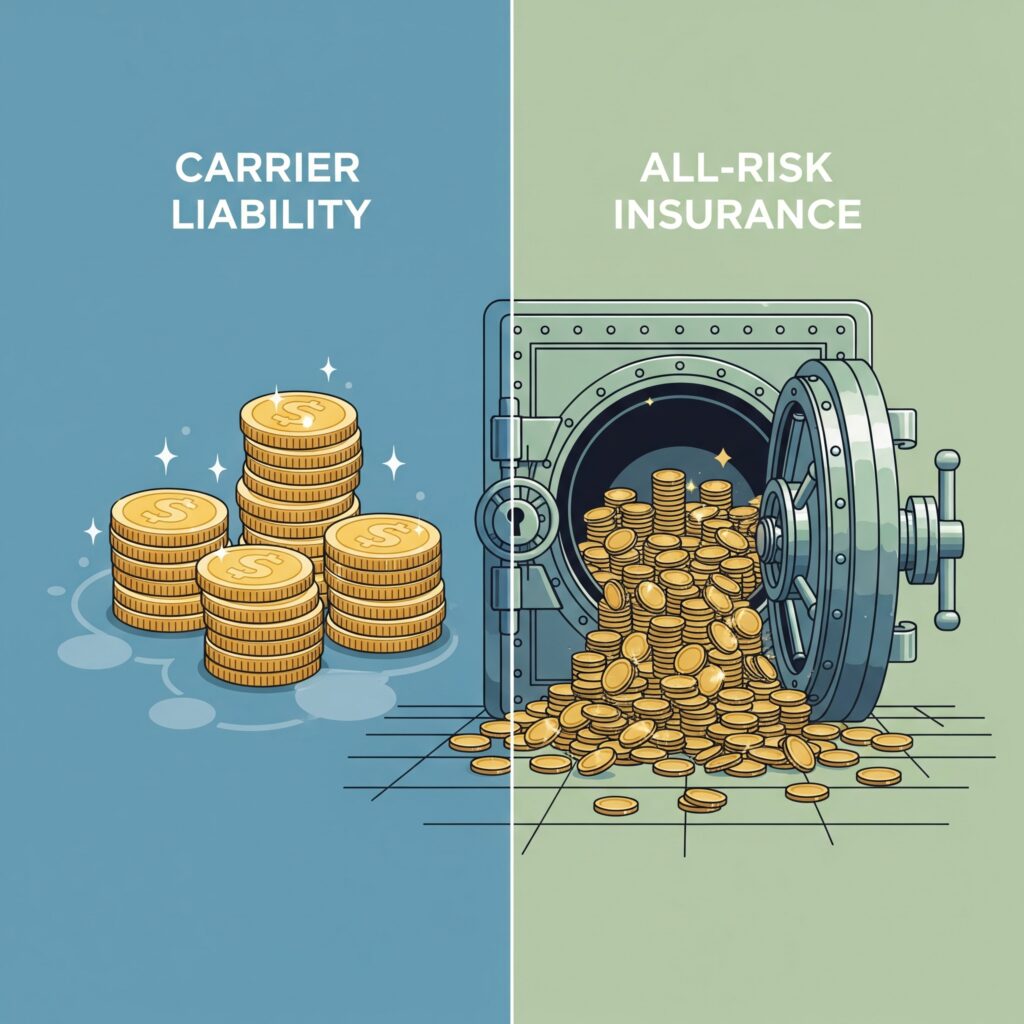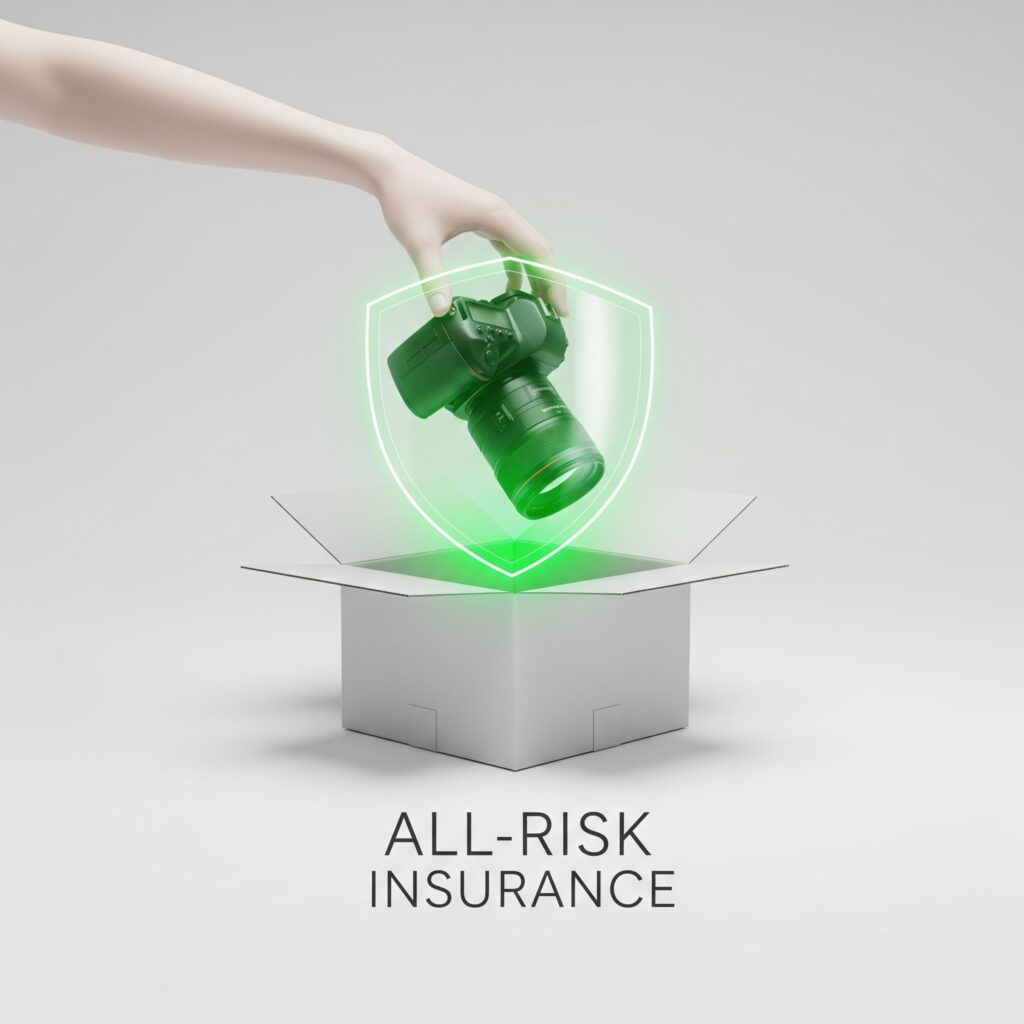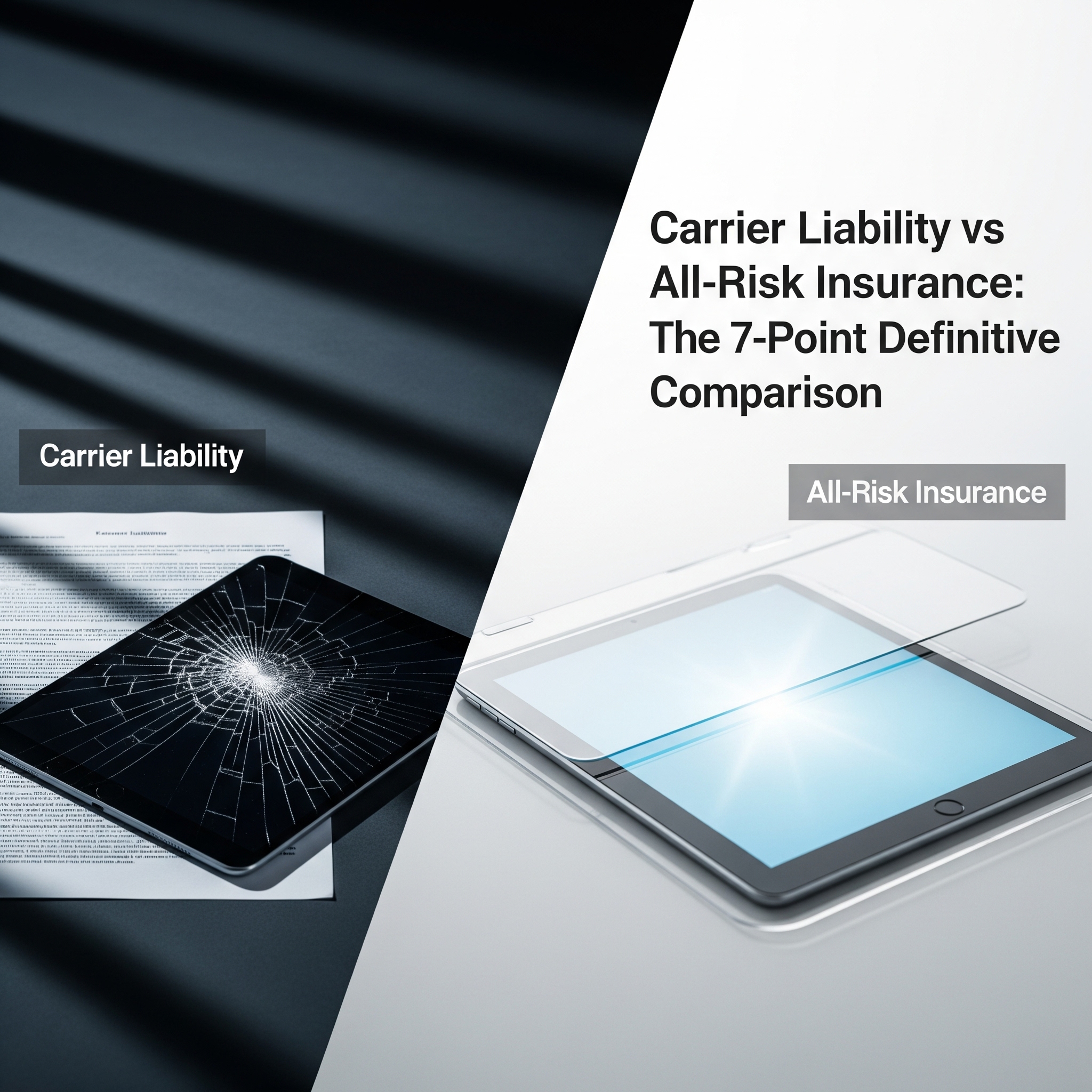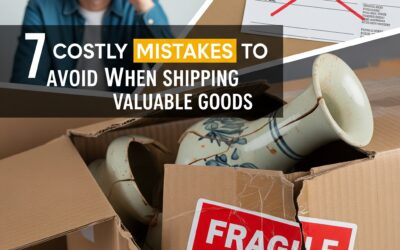In our previous guide, we uncovered the hidden financial risks of shipping. You learned that the default “coverage” offered by carriers is not true insurance, but a system of limited liability that can leave your business exposed to devastating losses. You’ve had the “Oh no, I might be exposed” moment.
Now, you are at a crucial crossroads, ready to move from understanding the problem to actively choosing a solution. You are faced with a fundamental choice: do you stick with the basic protection offered by your carrier, perhaps paying extra for a slightly higher “declared value,” or do you opt for a dedicated solution called “All-Risk Shipper’s Interest Insurance”?
To the untrained eye, these options can seem like shades of the same color. In reality, they are black and white. Choosing between them is one of the most important financial decisions you can make for your logistics operations. This guide is designed to provide ultimate clarity. We will conduct a definitive, head-to-head comparison of carrier liability vs all-risk insurance, breaking down the seven most critical differences that impact your bottom line, your time, and your peace of mind.

Carrier Liability vs All-Risk Insurance: A Head-to-Head Analysis
The decision-making process for protecting your shipments can feel complex, filled with fine print and confusing terminology. To cut through this noise, we’ve created a simple, at-a-glance comparison chart that summarizes the essential differences. Think of this as the ultimate cheat sheet for shipment protection.
While this table provides the answers, the rest of this guide will explain the profound business implications behind each row, empowering you to make the most informed decision possible.
The Ultimate Cheat Sheet: Your At-a-Glance Comparison
| Feature | ShipSimple All-Risk Insurance | Standard Carrier Liability | Why This Matters for Your Shipment |
| Coverage Limits | Up to $250,000 for Parcels. Up to $500,000 for Freight | Typically $100 – $500 (parcel), $2/lb – $25/lb (freight) | Financial Risk: Your business bears the brunt of losses beyond these minimal limits, regardless of how your goods travel. |
| Coverage Type | All-Risk Shipper’s Interest (Covers Most Perils) | Limited Perils (Covers only specific, few events) | Peace of Mind: “All-Risk” covers far more scenarios, protecting against theft, damage, loss, and more, across all transportation methods. |
| Deductibles | None for Parcel | Often Applicable | True Value: No hidden costs eating into your reimbursement, whether for a small package or a large cargo. |
| Claim Process | Fast, Easy, No Red Tape! | Slow, Complex, High Burden of Proof | Business Continuity: Get back on track quickly with our streamlined process, minimizing downtime across your entire supply chain. |
| Proof Required | Simple Online Reporting | Extensive Documentation & Investigation | Time Saved: Focus on your business, not endless paperwork, regardless of the shipment type. |
| Payer | Backed by CNA (A-rated Global Insurer) | Carrier/Courier (Internal Process) | Reliability: Confident in secure, timely payouts from an industry leader, for any type of shipment. |
| Applicability | Covers All Major Carriers/Couriers (Multi-Carrier/Courier) | Limited to Specific Carrier/Courier | Flexibility: Use your preferred carriers (land, ocean, or air) while maintaining consistent, high-level protection. |
A Deep Dive Into the 7 Critical Differences
Now, let’s break down exactly what each row on that chart means for your business.
1. Coverage Limits: The Difference Between a Setback and a Shutdown
This is the most immediate and impactful difference when comparing carrier liability vs all-risk insurance. The gap in coverage limits is not just a gap; it’s a chasm that can swallow a small business whole.
Standard carrier liability is designed to be minimal. The “$2/lb” rule for freight is infamous. Let’s consider a realistic scenario: you are shipping a pallet of specialized industrial sensors. The pallet weighs 500 lbs and has an invoice value of $75,000. The truck is involved in an accident, and the entire shipment is a total loss.
- Under Standard Carrier Liability: Your maximum payout would be 500 lbs x $2/lb = $1,000.
- Your Financial Loss: $75,000 – $1,000 = $74,000.
For most businesses, an unexpected and unrecoverable loss of $74,000 is a catastrophic event. It can halt projects, ruin client relationships, and severely impact cash flow. With parcel shipments, the default is often a flat $100 limit. If your e-commerce business ships a $1,500 laptop that gets lost, you are out $1,400.
ShipSimple’s All-Risk Insurance is built for the reality of modern commerce. With limits up to $250,000 for parcels and $500,000 for freight, you can confidently ship high-value goods knowing that your financial interest is fully protected. This isn’t just about covering the cost of the goods; it’s about ensuring your business’s solvency and stability.
2. Coverage Type: The Chasm Between “Limited Perils” and “All-Risk”
If coverage limits are about the amount of protection, coverage type is about the quality and scope of that protection.
Carrier liability is a form of “Limited Perils” or “Named Perils” coverage. This means it only covers losses from a very small, specific list of causes where their direct negligence can be proven. This list typically includes things like a vehicle fire or a complete turnover of the truck.
Crucially, it excludes the most common causes of damage for valuable goods:
- Water damage from rain on a loading dock.
- Concealed damage from vibration or shock.
- Damage from extreme heat or cold.
- Theft from a porch or receiving area.
- “Acts of God” like floods or storms.
“All-Risk” Shipper’s Interest Insurance operates on the opposite principle. It covers your goods for all risks of physical loss or damage from any external cause. The only exceptions are a few common-sense exclusions that are clearly listed in the policy (e.g., improper packaging by the shipper, inherent vice, acts of war).
Think of it like this: With carrier liability, the shipment is assumed to be uncovered, and you have the immense burden of proving it falls under one of their few covered perils. With All-Risk insurance, the shipment is assumed to be covered, and the insurer would have to prove the loss was caused by a specific exclusion. This fundamental shift in the burden of proof is the core of “peace of mind.”
3. Deductibles: The Hidden Cost in Your Payout
A deductible is the amount of money you have to pay out-of-pocket before your coverage kicks in. It’s another way that carriers can minimize their payouts. Many carrier liability policies, especially for freight, come with a deductible that can range from hundreds to thousands of dollars.
Imagine your $10,000 shipment is damaged, and the carrier agrees to a payout. If your policy has a $1,000 deductible, the maximum you will receive is $9,000. For smaller claims, a high deductible can wipe out the entire payout, making the coverage effectively useless.
ShipSimple’s All-Risk insurance for parcels features no deductible. For freight, deductibles are clearly stated and are often much lower or can be adjusted. This means you receive the true value of your reimbursement without hidden costs eating into your recovery.
4. The Claim Process: A Tale of Two Experiences
When a shipment goes wrong, the last thing you need is a long, difficult, and adversarial claims process. The user experience of filing a claim is a defining factor in the carrier liability vs all-risk insurance debate.
The carrier claims process is a notorious “claims gauntlet.” You are dealing with an internal department of the same company that lost or damaged your goods. Their primary incentive is to protect their company’s bottom line by minimizing payouts. The process is characterized by:
- Long, complicated forms.
- A high burden of proof placed on you.
- Slow response times, often taking months to resolve.
- An adversarial tone, where you feel like you are being investigated.
ShipSimple’s “White-Glove” claims process is designed to be a customer service experience. We are your partner. Our incentive is to get your claim resolved fairly and quickly so you can get back to business. The process is characterized by simple online reporting, a dedicated support team that advocates for you, and a focus on fast resolution. This is what “Business Continuity” truly means—minimizing the disruption to your operations so you can keep moving forward.

5. Proof Required: The Burden of Evidence
This is directly tied to the claims process. Why is the carrier process so difficult? Because of the extensive proof they require. To approve a claim, you must unequivocally prove that the carrier’s direct negligence caused the loss. This often requires documentation you simply don’t have.
For example, to prove damage, a carrier may require:
- The original invoice for the item.
- Detailed photos of the item and all six sides of the box.
- Photos of the internal packaging materials.
- A signed statement from the recipient detailing the damage upon arrival.
- A formal repair estimate from a certified technician.
Failure to provide any one of these items can be grounds for denial.
With an All-Risk policy from ShipSimple, the proof required is much simpler. You need to demonstrate that a loss occurred while the item was in transit and provide proof of its value (the commercial invoice). The process is designed to validate a legitimate claim, not to find a loophole to deny it. The time saved on paperwork and investigation is a massive productivity gain for your business.
6. The Payer: The Critical Importance of Financial Backing
Who writes the check when your claim is approved? This is a crucial question of reliability.
With carrier liability, the payer is the carrier itself. They are paying out of their own operational budget. This creates the conflict of interest we’ve discussed, as every dollar they pay you is a dollar off their bottom line.
ShipSimple’s All-Risk insurance is backed by CNA, a multi-billion dollar, A-rated global insurance leader. This means your policy is underwritten by one of the most financially stable and reputable insurers in the world. This is not just a detail; it’s the foundation of your policy’s reliability. It guarantees that the funds are secure and that the claims are handled according to the highest professional insurance standards. It provides absolute confidence in secure and timely payouts.
7. Applicability: The Freedom of a Multi-Carrier Solution
Finally, consider the strategic flexibility of your business.
When you rely on carrier liability, your protection is tied to that specific carrier. If you find a faster or cheaper route with a different carrier, you are now subject to their different and likely equally restrictive liability terms. Your protection level is inconsistent and fragmented across your supply chain.
ShipSimple’s All-Risk insurance is carrier-agnostic. It is a consistent, high-level layer of protection that covers your shipments regardless of which major carrier you choose—be it Purolator, UPS, FedEx, or any number of LTL freight carriers. This decouples your risk management strategy from your carrier selection strategy. It gives you the ultimate flexibility to optimize your logistics for speed and cost without ever having to compromise on the quality of your financial protection.
Conclusion: An Obvious Choice for a Smarter Business
When you conduct a true, head-to-head comparison of carrier liability vs all-risk insurance, the conclusion is clear and undeniable. It’s not a choice between two similar options; it’s a choice between a system of minimal legal protection designed for the carrier and a comprehensive service designed for you, the shipper.
One path is defined by high financial risk, limited coverage, hidden costs, and a frustrating, time-consuming claims process. The other path is defined by financial security, broad protection, transparency, and a fast, supportive experience that enables business continuity. The choice is not just about a single shipment; it’s a fundamental business strategy decision.
You’ve seen the definitive comparison and the clear winner. The next step is to see how this superior protection seamlessly integrates into your daily workflow. Discover the ShipSimple platform and see why thousands of businesses have made the smart choice to protect their shipments the right way.

Additional Resources
- Defining Insurance Terms
- The Business Importance of Risk Transfer
- Financial Stability of Insurers
- Supply Chain Flexibility
- Business Continuity Planning
- Learn More About High Value Shipping Coverage
- Learn More About Parcel Shipping Insurance
- Learn More About Freight / Cargo Shipping Insurance
- See Our Other Helpful Blogs





